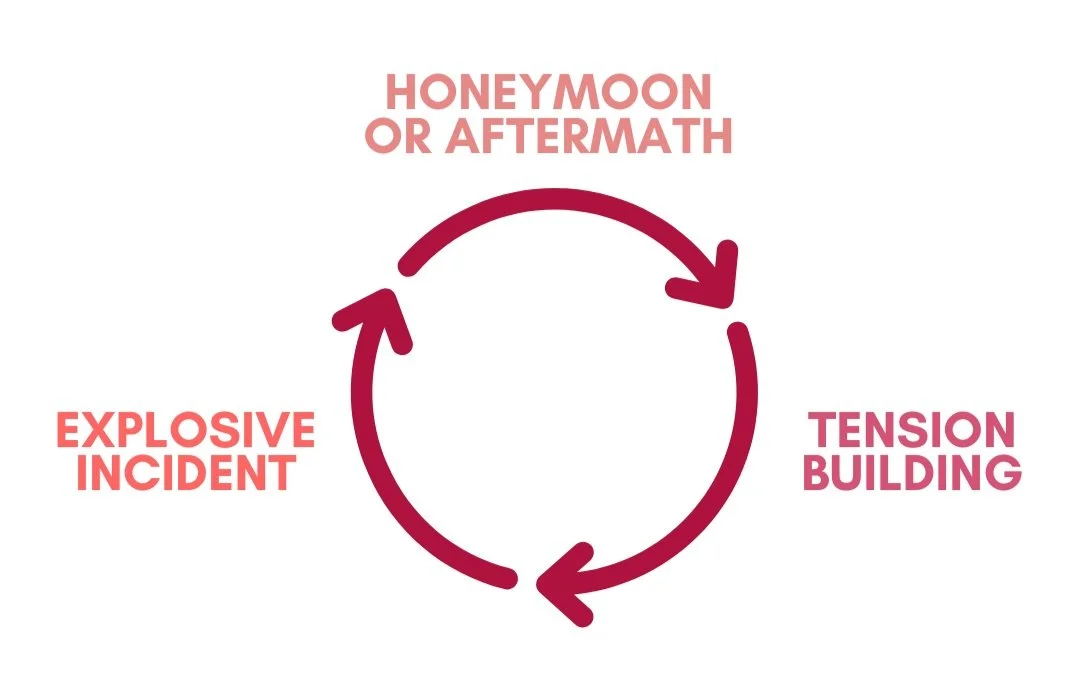The Facts: Intimate Partner Violence
WHAT IS INTIMATE PARTNER VIOLENCE (IPV)?
Intimate partner violence (also known as domestic violence) is a pattern of controlling behavior where one partner (either in a dating, domestic/live-in, or married relationship) seeks to gain control over the other. Contrary to popular belief, partner violence is just as harmful and serious to teen victims, not just adults. Many abusive behaviors are similar to red flags generally found in non-strangers while there are several that are unique to intimate partner violence (especially if the couple are parents or live together). Note that not all behaviors will be present in every case. Still, if a relationship has several behaviors or the frequency or intensity of a particular behavior, there is reason for concern:
-
Any unwanted, harmful physical contact or attempt (whether or not it causes injury):
• Uses or threatens physical violence on you, others or animals/pets (e.g., hitting/slapping, strangling, grabbing, pushing, spitting, biting, hair-pulling)
• Uses or expresses interest in weapons to cause harm
• Expresses anger through yelling, breaking, or throwing things (even if they don’t hit anyone)
• Drives recklessly when angry
• Has a substance problem with alcohol or drugs
• Aggressive behavior escalates after substance use
• Coerces or forces you into alcohol or drug use
• Has a history with police encounters or a criminal record of violent behavior (e.g., assault, stalking)
-
Any unwanted sexual contact or use of sexuality to humiliate, hurt or control:
• Makes degrading or unwanted comments about your body or sexuality
• Talks about your intimate activities in public without your consent
• Uses pornography even if you feel uncomfortable
• Has an affair or threatens to have an affair
• Accuses you of having an affair to justify their controlling behavior
• Criticizes or controls your appearance, clothing, exercise and eating habits to suit their expectations (e.g., forces you to look “sexy” or cover up for him)
• Uses your sexuality/sexual history against you (e.g., calls you “dirty”/”used up” for having previous partners)
• Films or photographs explicit acts with you or of you without your consent
• Forces or pressures you to nonconsensual sexual/physical contact or activity
• Gets verbally or physically aggressive when you refuse sexual intimacy
• Willfully exposes you to sexually transmitted diseases (e.g., lies about test results, or refuses to get tested)
• Interferes with your contraception use and pregnancy:
• Forces you to get pregnant
• Tampers with your birth control and other contraception methods
• Controls your choices while pregnant
-
Any actions or words meant to manipulate, confuse or control you:
• Minimizes their behavior (e.g., “It’s not a big deal”)
• Lies and/or denies your recollection of events (e.g., “I never said that”)
• Actions do not align with their words (e.g., He says interrupting is rude but interrupts you in an argument)
• Ignores you after a fight or for no reason at all
• Plays the victim and blames aggressive behavior on:
• Alcohol or drugs (e.g., "It's the booze talking")
• You or other people (e.g., "You’re the reason I get like this", “This is how I was raised”)
• Pressure from work/studies (e.g., "I get like this when I’m stressed)
• Uses ultimatums, including threats or attempts of self-harm, to pressure you into complying (e.g., “You’ll do it if you love me”, “If you tell anyone about this, you’ll be sorry”)
-
Any actions or attempts to isolate you or control your ability to seek support:
• Controls who you spend time with and your ability to connect with others (e.g., forces you to stop seeing family, hides your phone)
• Behaves kindly towards friends and family but reserves hostile behavior towards you when no one else is around
• Ruins your reputation (e.g., spreads rumors)
• Threatens to “out” you if you are in a relationship that is considered taboo to your social circle (e.g., non-heteronormative, wide age/income gap, or different race/religion) which can lead to you losing support from friends and family
• Enlists the help of friends and family to convince you to stay in the relationship if you are showing signs of wanting to leave
• Uses friends and family to control you
• Conducts surveillance on you (e.g., stalking, cameras in your room, GPS locator on your car, constantly asking your whereabouts)
• Controls your movements within and outside your home or work/school (e.g., strict curfew, locked doors, or prevents you from traveling on your own)
-
Any actions that compromise your digital safety or privacy:
• Posts or threatens to post private or embarrassing information, photos, videos or stories of you on social media
• Uses your likeness or information without permission (e.g., deepfake videos, fake accounts)
• Sends frequent, unwanted messages (e.g., threats, explicit images)
• Coerces you to send explicit images or messages even if you feel uncomfortable (e.g., nudes, sexting)
• Monitors your messages, email, or social media without permission or with forced permission
-
Any actions that compromise your financial independence and security:
• Steals, hides or controls your money
• Withholds financial information
• Spends your money without your consent
• Refuses to pay back money/assets owed to you
• Coerces you to commit financial fraud
• Criticizes your spending (even if it isn’t excessive)
• Belittles your financial contributions
• Prevents or restricts you from working or moving forward at work (e.g., disrupts your meetings which causes you to get fired)
-
Any actions that damage you spiritually:
• Uses religious beliefs (theirs or yours) to justify behavior (e.g., “It is god’s will”)
• Attacks your beliefs
• Restricts you from practicing your faith
• Prevents your children from learning your faith
• Isolates you from your faith community
• Forces you to convert or adopt their beliefs
-
Any involvement, manipulation, threats or use of your children or other dependents, to intimidate or control you:
• Accuses you of being a terrible parent
• Belittles you in front of the children
• Lies to the children about you to rally them to their side
• Threatens to take children from you
• Threatens to harm or harms the children
• If you are separated or in the process of separating:
• Fights for custody of the children
• Uses visitation to harass you
• Refuses to pay child support
-
Any behavior that compromises or exploits your injury, disability or any chronic/acute health condition:
• Insults or degrades you based on your condition
• Refuses to bring you or forces that they should accompany you to appointments
• Theft or extortion of your medical benefits
• Intentionally provides inadequate and unsafe caregiving
• Compromises your living conditions (e.g., smoking indoors)
• Changes your medication without telling you
• Withholds, hides, destroys or manipulates your medical equipment (e.g., walker, hearing aid, wheelchair, insulin pump, EpiPen)
• Unwanted touching while assisting you with dressing, bathing or using the toilet
• Demands sexual favors in exchange for caregiving
• Withholds medical information from you (e.g., doctor’s recommendations)
I. INTIMATE PARTNER VIOLENCE: MYTHS VS. REALITY
II. CYCLE OF ABUSE
The Cycle of Abuse is the pattern of behaviors that is used to exert power and control over the partner. Like their behaviors, the cycle of abuse is within the abuser’s control, which means nothing their partner can do or say will influence or prevent the outcomes. The duration and effect of each phase varies for everyone and can be unpredictable, with the phases blurring together, or the abuser jumping from phase to phase in an instant or lingering on one before moving to the next.
-
During this phase, the target is subjected to seemingly minor yet hurtful behaviors:
• Silent treatment
• Putdowns (e.g., sarcasm, accusations, insults, faultfinding)
• Sudden mood changes (e.g., going from happy to sullen)
Although these behaviors are not violent, the partner feels threatened and alleviates the abuser’s anger with the hopes that their behavior will keep the violence at bay (e.g., acting on the abuser’s desires to "keep the peace.")
-
This is the most dangerous phase as the hostile behavior becomes physically violent or verbally hostile:
• Physical/sexual assault
• Yelling/making threats
• Throws/breaks things
The partner may lie about the incident, delay or not seek medical attention despite the severity of their injuries (e.g., “The bruises don’t hurt”), or minimize the aggression (e.g., “It wasn’t that bad, we didn’t argue for too long.”)
-
After the explosive incident, many abusers try to win back their victim’s approval by showering them with their “good side.” This phase is called the Honeymoon, which may be similar to the start of the relationship:
• Apologies, and promises to change
• Being considerate and patient (e.g., helping around the house)
• Giving gifts (e.g., jewelry, clothes, electronics, vacation)
• Being affectionate and romantic (e.g., compliments, going on dates)
Although it seems positive, it is manipulative as these acts are meant to convince the partner to stay, and not genuine efforts to stop the behavior. The Honeymoon can be very confusing for the partner, as it reminds them of what they want from the relationship and make them hopeful that the abuser will change. However, some partners can feel uncomfortable and pressured to accept the gifts and apologies, as the abuser may threaten them if they refuse (e.g., “Why can’t you appreciate what I’m doing for you?”)
In some cases, there is no Honeymoon period at all but simply an Aftermath phase, in which the abuser ignores their partner without acknowledging the incident and returns back to the tension building phase.
DUE TO THE COMPLICATIONS AND RISK OF GREATER VIOLENCE AND ABUSE, TRAINED PROFESSIONAL ASSISTANCE MAY BE REQUIRED. FOR MORE INFORMATION, PLEASE PROCEED TO SUPPORT SERVICES.
“Abuse doesn’t come from people’s inability to resolve conflicts but from one person’s decision to claim a higher status than another.”
L U N D Y B A N C R O F T
-
• Bancroft, Lundy. "Why Does He Do That: Inside the Minds of Angry and Controlling Men." Penguin Random House LLC. 2002.
• Cory, Jill & Karen McAndless-Davis. “When Love Hurts: A Woman's Guide to Understanding Abuse in Relationships.” Berkley. 2016.
• Government of Canada. “An Estimation of the Economic Impact of Spousal Violence in Canada, 2009.” 2021.
—. “Fact sheet: Intimate Partner Violence.” Women and Gender Equality Canada. 2022.
• Snyder, Rachel Louise. “No Visible Bruises: What We Don’t Know About Domestic Violence Can Kill Us.” Bloomsbury Publishing. 2019.
• Sutton, Danielle. “Gender-related homicide of women and girls in Canada.” Statistics Canada. April 2023.




